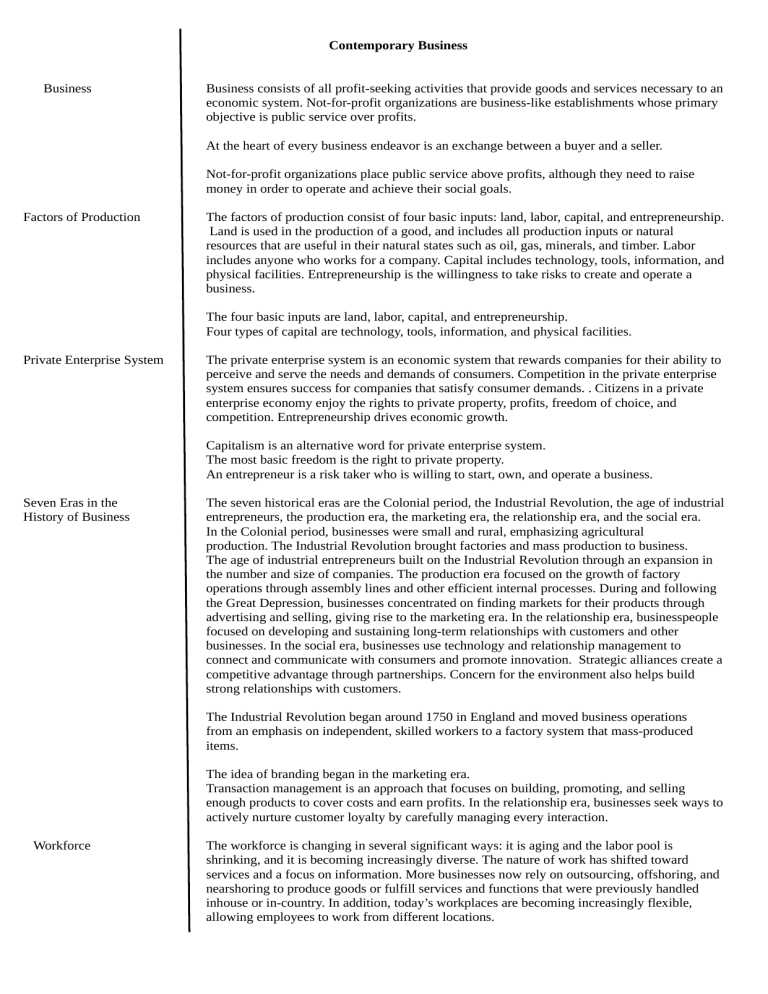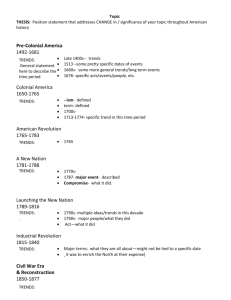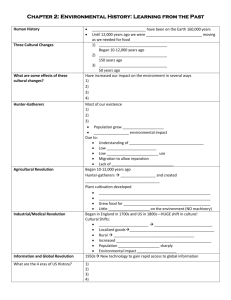
Contemporary Business Business Business consists of all profit-seeking activities that provide goods and services necessary to an economic system. Not-for-profit organizations are business-like establishments whose primary objective is public service over profits. At the heart of every business endeavor is an exchange between a buyer and a seller. Not-for-profit organizations place public service above profits, although they need to raise money in order to operate and achieve their social goals. Factors of Production The factors of production consist of four basic inputs: land, labor, capital, and entrepreneurship. Land is used in the production of a good, and includes all production inputs or natural resources that are useful in their natural states such as oil, gas, minerals, and timber. Labor includes anyone who works for a company. Capital includes technology, tools, information, and physical facilities. Entrepreneurship is the willingness to take risks to create and operate a business. The four basic inputs are land, labor, capital, and entrepreneurship. Four types of capital are technology, tools, information, and physical facilities. Private Enterprise System The private enterprise system is an economic system that rewards companies for their ability to perceive and serve the needs and demands of consumers. Competition in the private enterprise system ensures success for companies that satisfy consumer demands. . Citizens in a private enterprise economy enjoy the rights to private property, profits, freedom of choice, and competition. Entrepreneurship drives economic growth. Capitalism is an alternative word for private enterprise system. The most basic freedom is the right to private property. An entrepreneur is a risk taker who is willing to start, own, and operate a business. Seven Eras in the History of Business The seven historical eras are the Colonial period, the Industrial Revolution, the age of industrial entrepreneurs, the production era, the marketing era, the relationship era, and the social era. In the Colonial period, businesses were small and rural, emphasizing agricultural production. The Industrial Revolution brought factories and mass production to business. The age of industrial entrepreneurs built on the Industrial Revolution through an expansion in the number and size of companies. The production era focused on the growth of factory operations through assembly lines and other efficient internal processes. During and following the Great Depression, businesses concentrated on finding markets for their products through advertising and selling, giving rise to the marketing era. In the relationship era, businesspeople focused on developing and sustaining long-term relationships with customers and other businesses. In the social era, businesses use technology and relationship management to connect and communicate with consumers and promote innovation. Strategic alliances create a competitive advantage through partnerships. Concern for the environment also helps build strong relationships with customers. The Industrial Revolution began around 1750 in England and moved business operations from an emphasis on independent, skilled workers to a factory system that mass-produced items. The idea of branding began in the marketing era. Transaction management is an approach that focuses on building, promoting, and selling enough products to cover costs and earn profits. In the relationship era, businesses seek ways to actively nurture customer loyalty by carefully managing every interaction. Workforce The workforce is changing in several significant ways: it is aging and the labor pool is shrinking, and it is becoming increasingly diverse. The nature of work has shifted toward services and a focus on information. More businesses now rely on outsourcing, offshoring, and nearshoring to produce goods or fulfill services and functions that were previously handled inhouse or in-country. In addition, today’s workplaces are becoming increasingly flexible, allowing employees to work from different locations. And with artificial intelligence (AI) to become more efficient, companies are fostering innovation through teamwork and collaboration. Outsourcing involves using outside vendors to produce goods or fulfill services and functions that were once handled in house. Offshoring is the relocation of business processes to lower-cost locations overseas. Nearshoring is the outsourcing of production or services to locations near a company’s home base. Businesses are increasingly focusing on collaboration rather than on individuals working alone. No longer do employees just put in their time at a job they hold their entire career. The new employer–employee partnership encourages teamwork, creative thinking, and problem solving. Skills and Attributes For today’s managers, the ability to communicate and strategically apply critical thinking skills and creativity to both challenges and opportunities will be a top priority. Critical-thinking skills and creativity allow managers to pinpoint problems and opportunities and plan novel solutions. Finally, managers are dealing with rapid change, and they need skills to help lead their organizations through shifts in external and internal conditions. To thrive in the 21st century, managers need vision, the ability to perceive marketplace needs and to determine what an organization must do to satisfy those needs. Critical thinking is the ability to analyze and assess information to pinpoint problems or opportunities. Creativity is the capacity to develop novel solutions to perceived organizational problems. Admired Company A company is usually admired for its solid profits, stable growth, a safe and challenging work environment, high-quality goods and services, and business ethics and social responsibility. Business ethics refers to the standards of conduct and moral values involving decisions made in the work environment. Social responsibility is a management philosophy that includes contributing resources to the community, preserving the natural environment, and developing or participating in nonprofit programs designed to promote the well-being of the general public.. Criteria in judging whether companies are admirable include three of the following: solid profits, consistent growth, a safe and challenging work environment, high-quality goods and services, and business ethics and social responsibility.


